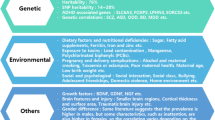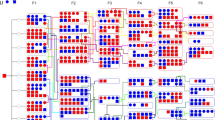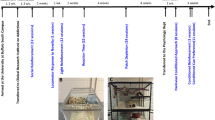Abstract
The syndrome of hyperactivity describes behavioural disorders existing mainly in children and characterized by increased levels of motor activity, inattention and impulsivity1,2. Overall the aetiology is poorly understood due to the heterogeneity of the pathology although psychological, biological and social factors acting singly or in concert are generally thought to be involved. In animal studies the observed hyperactivity phenotype results from relative participation of exploration, emotionality and general activity3. Studies using brain lesions3, neuropharmacology4 and gene knock-out strategies5,6 have shown that specific elements of the brain dopaminergic system can subserve hyperactivity. Evidence of a genetic contribution comes from family7,8 and twin studies9 but also from the ability to select divergent animal lines on the basis of their differential activity. The Wistar-Kyoto (WKY) and Wistar-Kyoto hyperactive (WKHA) rats are such strains — distinct for their low and high activity scores in a novel environment, respectively10. Here, we report the detection of a major hyperactivity-related QTL on chromosome 8, explaining 29% of the variance of an intercross between these strains. This study represents the first behavioural QTL analysis in rat and provides a new starting point for biologically categorizing different forms of hyperactivity.
This is a preview of subscription content, access via your institution
Access options
Subscribe to this journal
Receive 12 print issues and online access
$209.00 per year
only $17.42 per issue
Buy this article
- Purchase on Springer Link
- Instant access to full article PDF
Prices may be subject to local taxes which are calculated during checkout
Similar content being viewed by others
References
Voeler, K.K.S. Toward a neurobiologic nosology of attention deficit hyperactlvity disorder. J. Child Neural. 6, S2–S6 (1991).
Schachar, R. Childhood hyperactivity; J. Child Psychol. Psychiat. 32, 155–191 (1991).
Kelley, A.E., Cador, M. & Stinus, L. Exploration and its measurements. in Neuromeffrods. 95–114 (Humana Press. Clifton NJ, (1989).
Mogenson, G.J. & Nielsen, M. Neuropharmacoligcal evidence to suggest that the nucleus accumbens and subpallidal region contribute to exploratory locomotion. Behav. Neural. Biol. 42, 52–60 (1984).
Xu, M. et al. Elimination of cocaine-induced hyperactivity and dopamine mediated neurophysiological effects in dopamine D1 receptor mutant mice. Cell 79, 946–955 (1994).
Giros, B., Jaber, M., Jones, S.R., Wightman, R.M. & Caron, M.G. Hypertocomotion and indifference to cocaine and amphetamine in mice lacking the dopamine transporter. Nature 379, 606–612 (1996).
Biederman, J. et al. Further evidence for family risk factor in attention deficit hyperactivity disorder. Arch. Gen. Psychiat. 49, 728–738 (1992).
Faraone, S.V., Biederman, J., Keenan, K. & Tsuang, M.T. A family-genetic study of girts with DSM-III attention deficit disorder. Am. J. Psychiat. 148, 112–117 (1991).
Thapar, A., Herves, A. & McGuffin, P. Childhood hyperactivity scores are highly heritable and show sibling competition effects: twin study evidence. Behav. Gen. 25, 537–544 (1995).
Hendley, E.D. & Ohlsson, W.G. Two new inbred strains derived from SHR: WKHA, hyperactive, and WKHT, hypertensive rats. Am. J. Physiol. 261, H583–589 (1991).
Castanon, N., Hendley, E.D., Fan, X.-M. & Morméde, P. Psychoneuroendocrine profile associated with hypertension or hyperactivity in the spontaneously hypertensive rat. Am. J. Physiol. 265, R1304–1310 (1993).
Hendley, E.D. & Fan, X.-M. Regional differences in brain norepinephrine and dopamine uptake kinetics in inbred rat strains with hypertension and/or hyperactivity. Brain Res. 586, 44–52 (1993).
Courvoisier, H., Moisan, M.-P., Sarrleau, A., Hendley, E.D. & Morméde, P. Behavioral and neuroendocrine reactivity to stress in the WKHA/WKY inbred rat strains: a multifactorial and genetic analysis. Brain Res. (in the press).
van Dijken, H.H., van der Heyden, J.A.M., Mos, J. & Tilders, F.J.H. Inescapable footshocks induce progressive and long-lasting behavioral changes in male rats. Physiol. Behav. 51, 787–794 (1992).
Knott, S.A., Haley, C.S. & Thompson, R. Methods of segregation analysis for animal breeding data: parameter estimates. Heredity 68, 313–320 (1992).
Nelson, J.C., Qgene: Macintosh software for QTL detection and manipulation in Plant Genome IV (San Diego, January 14–18) 315A (1995).
Lander, E.S. MAPMAKER: an interactive computer package for constructing primary genetic linkage maps of experimental and natural populations. Genomics 1, 174–181 (1987).
Lander, E.S. & Kruglyak, L. Genetic dissection of complex traits: guidelines for interpreting and reporting linkage results. Nature Genet. 11, 241–247 (1995).
Flint, J. et al. A simple genetic basis for a complex psychological trart in laboratory mice. Science 269, 1432–1435 (1995).
Walsh, R.N., Cummins, R.A. The open-field test: a critical review. Psychol. Bull. 83, 482–504 (1976).
Cook, E.H. et al. Association of attention-deficit disorder and the dopamine transporter gene. Am. J. Hum. Genet. 56, 993–998 (1995).
Hess, E.J., Collins, K.A. & Wilson, M.C. Mouse model of hyperkinesis implicates SNAP-25 in behavioral regulation. J. Neurosci. 16, 3104–3111 (1996).
Bihoreau, M.-T. unpublished data; available by anonymous ftp from ftp://ftp.well.ox.ac.uk/pub/genetics/ratmap.
Churchill, G.A. & Doerge, R.W. Empirical threshold values for quantitative trait mapping. Genetics 138, 963–971 (1994).
Author information
Authors and Affiliations
Rights and permissions
About this article
Cite this article
Moisan, MP., Courvoisier, H., Bihoreau, MT. et al. A major quantitative trait locus influences hyperactivity in the WKHA rat. Nat Genet 14, 471–473 (1996). https://doi.org/10.1038/ng1296-471
Received:
Accepted:
Issue Date:
DOI: https://doi.org/10.1038/ng1296-471
This article is cited by
-
The influence of sex and estrous cycle on QTL for emotionality and ethanol consumption
Mammalian Genome (2011)
-
QTL analyses of temporal and intensity components of home-cage activity in KJR and C57BL/6J strains
BMC Genetics (2009)
-
The characteristics of motor activity in ISIAH rats in an open field test are controlled by genes on chromosomes 2 and 16
Neuroscience and Behavioral Physiology (2009)
-
Quantitative Trait Locus Analysis Identifies Rat Genomic Regions Related to Amphetamine-Induced Locomotion and Gαi3 Levels in Nucleus Accumbens
Neuropsychopharmacology (2008)
-
Effect of Monoamine Oxidease A Knockout on the Expression of 5-HT1A Receptors
Doklady Biological Sciences (2005)



